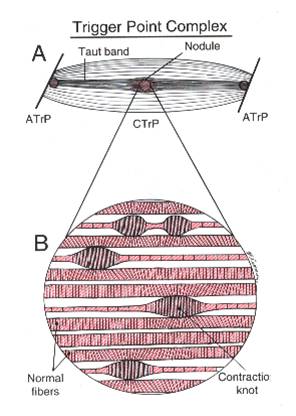

The presence of referred pain depends on the amount of pressure applied and thus also depends on subcutaneous thickness the pressure of compression was adjusted to a constant level by applying digital pressure that caused the finger to blanch. Referred pain was defined as any pain felt away from the area of palpation. The taut band can be snapped or rolled under the finger in accessible muscles. A taut band can be felt as a rope-like induration that extends from a trigger point nodule to the attachment of the taut muscle fibers at each end of the muscle. A force of approximately 2 kg was applied in order to palpate the trigger point or to elicit reproducible pain. During palpation or compression of that point, reproduction of recognized pain was taken as one of the criteria for MPS diagnosis. A trigger point was identified when a painful nodule on a muscle was felt through either a flat or pincer palpation technique. Initially, patients were requested to point to the painful spot with one finger in order to locate a trigger point. MPS diagnosis was based upon the presence of a trigger point, reproducible pain, taut band, referred pain and jump sign. Data examined included patient demographic features, duration of back pain, muscle(s) involved, primary diagnosis, treatment modality and response to treatment. The purpose of this study was to review our experience with MPS in patients with chronic back pain in order to provide local data on prevalence, risk factors and outcome of patients with MPS.Īfter approval by the Ethics Committee of University Science Malaysia, a prospective observational study was carried out on 126 consecutive patients who attended the Pain Management Unit at Hospital University Science Malaysia, Kelantan, between 1st January and 31st December 2009 for chronic back pain (i.e. Despite the prevalence of MPS, awareness among clinicians is still inadequate, which results in this condition often being misdiagnosed or underdiagnosed and thus under-treated. It accounts for 20% to 95% of patients with musculoskeletal pain presenting at general medical clinics and pain management centres. MPS is a common cause of pain and dysfunction in the musculoskeletal system. A myofascial trigger point is defined as a hyperirritable spot, usually within a taut band of skeletal muscle or in the muscle fascia, which is painful on compression and can give rise to characteristic referred pain, motor dysfunction, and autonomic phenomena. Myofascial pain syndrome (MPS) is a trigger point-induced regional musculoskeletal pain disorder affecting one or more muscles or groups of muscles. Keywords: chronic back pain, myofascial pain syndrome, trigger point With proper diagnosis and expert management, MPS has a favourable outcome. MPS prevalence among chronic back pain patients was significantly high, with female gender being a significant risk factor. Repeated measures analysis showed significant changes ( P < 0.001) in Visual Analogue Score (VAS) and Modified Oswestry Disability Score (MODS) with standard management during three consecutive visits at six-month intervals. Occupation, body mass index and duration of back pain were not significantly associated with MPS occurrence. There was an association between female gender and risk of developing MPS (χ 2 = 5.38, P = 0.02, O.R. Secondary MPS was more common than primary MPS, making up 81.3% of the total MPS. The prevalence of MPS among chronic back pain patients was 63.5% (n = 80). Data examined included demographic features of patients, duration of back pain, muscle(s) involved, primary diagnosis, treatment modality and response to treatment. This was a prospective observational study involving 126 patients who attended the Pain Management Unit for chronic back pain between 1st January 2009 and 31st December 2009. The objective of this study was to determine the prevalence of MPS among chronic back pain patients, as well as to identify risk factors and the outcome of this disorder. Myofascial pain syndrome (MPS) is a regional musculoskeletal pain disorder that is caused by myofascial trigger points.


 0 kommentar(er)
0 kommentar(er)
